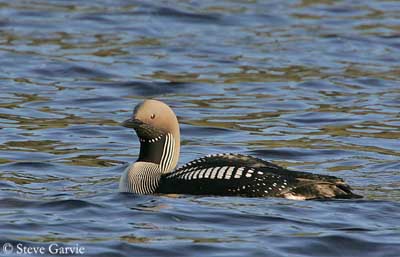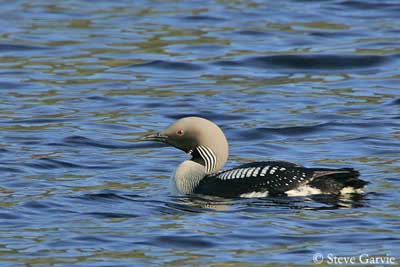
Black-throated Diver or Arctic Loon
Gavia arctica
Gaviiforme Order – Gaviidae Family
BIOMETRICS:
Length: 58-73 cm
Wingspan: 110-130 cm
Weight: 1300-3400 g
DESCRIPTION:
Black-throated Diver is a large swimming and diving bird. Relatively similar to grebes, the diver differs by its webbed feet with the three front toes joined by the membrane, and its short tail.
The name “diver” is given in Eurasia, whereas the name “loon” is usually used in North America.
In breeding plumage, the Black-throated Diver has dark upperparts, almost black, but with broad white-streaked areas with scaled effect.
Head and hind neck are grey. Fore neck and throat show black patch, vertically white-streaked on the sides.
We can see a short collar of small white spots which separates the throat from the upper neck. Breast is white finely streaked black.
Underparts are very pale, almost white.
PROTECTION / THREATS / STATUS:
The Black-throated Diver is vulnerable to human disturbances on the breeding areas. Changes in the habitat, alterations of water levels, acidification of these waters and oil and heavy metal pollution are important threats for this species.
However, populations are probably fairly large but with progressive decline throughout the southern part of the range.
Fr: Plongeon arctique
All: Prachttaucher
Esp: Colimbo Ártico
Ital: Strolaga mezzana
Nd: Parelduiker
Russe: Чернозобая гагара
Sd: Storlom
Photographs by Steve Garvie
RAINBIRDER Photo galleries
Text by Nicole Bouglouan
Sources:
HANDBOOK OF THE BIRDS OF THE WORLD vol 1 by Josep del Hoyo-Andrew Elliot-Jordi Sargatal - Lynx Edicions - ISBN: 8487334105
THE COMPLETE BOOK OF BRITISH BIRDS – Written by “Royal Society for the Protection of Birds” experts - Préface de Magnus Magnusson - Michael Cady- Rob Hume Editors - ISBN: 0749509112
THE HANDBOOK OF BIRD IDENTIFICATION FOR EUROPE AND THE WESTERN PALEARCTIC by Mark Beaman, Steve Madge - C.Helm - ISBN: 0713639601

In winter plumage, crown and nape are grey, back is darker grey-brown slightly spotted, and we can see a white patch on flanks. The grey of the crown extends below the deep red eyes. The fore neck is white, bordered with fine black line.
The head is held upwards and horizontally, as the straight grey bill. Legs and webbed feet are black.
Both sexes are similar.
Juvenile resembles adults in winter plumage. It has spotted back with weaker scaly effect. The chin shows a weak patch.
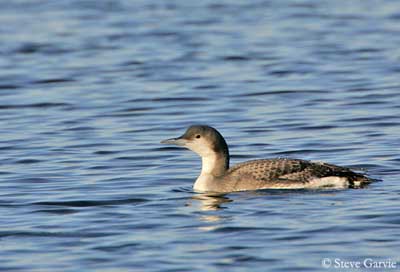
We can find three subspecies, “arctica”, “pacifica” and “viridigularis”. The race “pacifica” is smaller with paler head and hind neck, and thinner bill. The race “viridigularis” has green throat patch.
VOICE: SOUNDS BY XENO-CANTO
The Black-throated Diver is silent during winter and in flight. It gives deep territorial calls at night, short and intense gull-like wailings.
The alarm call is a croaking raven-like sound. Contact call used between parents and chicks and also by male during the copulation is a low-pitched moaning call.
The song uttered on the breeding areas is deep and monotonous “kluiee-ku-kluiee-ku-kluiee”.
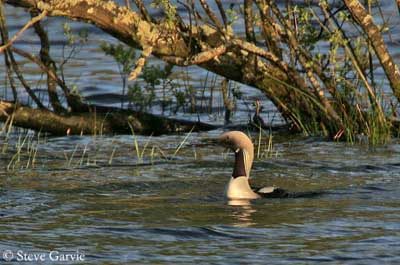
HABITAT:
The Black-throated Diver breeds on large, deep lakes with islets, and more typically in taiga and boreal area. The rest of the year, this species is found near coastal sheltered waters, rarely inland, except during the migrations.
RANGE:
The Black-throated Diver has circumpolar range, in cold and temperate arctic latitudes. It breeds in northern Scotland, Scandinavia and half-north Russia. It winters southwards along the Pacific coasts of North America, also coasts of NW Europe and Black, Caspian and Mediterranean Seas, and in NW Pacific.
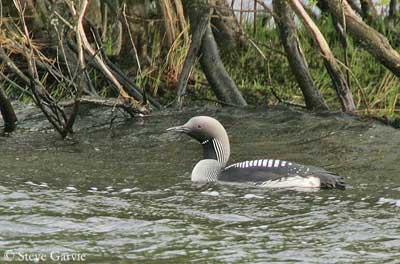
BEHAVIOUR:
The Black-throated Diver feeds primarily on fish of different species and also takes some other aquatic invertebrates.
If necessary, it will fly over 10 km in order to find food. To fish, it dives during about 45 seconds and to 3-6 metres depth. It may pursue the fish before to catch it. It is able to use the wings to “swim” under water. It dives head first and glides into the water without any disturbance.
During the migration, several hundreds of birds are moving, but they always travel in small groups.

Divers are usually monogamous and pair-bonds lasts all the life. The same nest-site is often reused year after year.
The pairs already established perform a few displays consisting of mutual “bill-dipping”, “splash-diving” and “rushing” under water. Copulation occurs on dry area and repeatedly.
Usually, the male selects the nest-site always close to the water. They are highly territorial on the breeding areas. They use aggressive postures and do not tolerate any intruder within their field of vision.
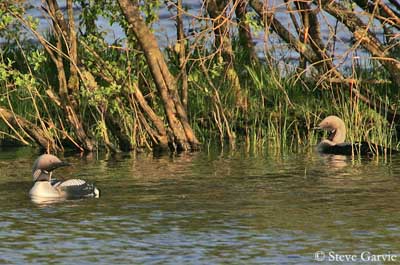
The bird raises its neck in order to display the throat patch and the neck pattern. Some displays are similar to courtship behaviour with in addition, several water chases with flapping wings. Territorial calls are uttered during these displays.
Fights are not frequent, but they may be intense and violent, using bill and wings, and occasionally, one bird, or both, may die.

FLIGHT:
The Black-throated Diver has slender silhouette when in flight, and performs wing-beats with flexible wing tips. It runs over water to take off because even with its large wingspan, the wing surface is small compared to the body size.
REPRODUCTION:
Breeding season starts in May in the southern parts of the range, and depends on the spring in the northern parts.
The Black-throated Diver is solitary nester. The nest varies from a scrape in the ground to a heap of plant matter close to the water.
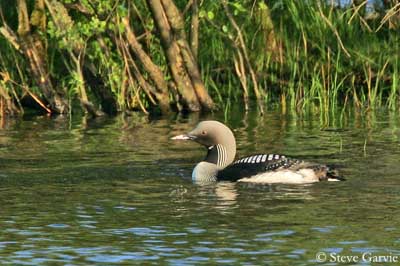
Female usually lays 1-3 olive-brown eggs with dark brown spots. Incubation by both adults lasts about 28-30 days. Chicks are covered in sooty brown down above and paler below. They grow during 12-13 weeks reared by both adults. They are able to feed themselves at this moment. They can fly at two months, and they reach their sexual maturity at 2-3 years.
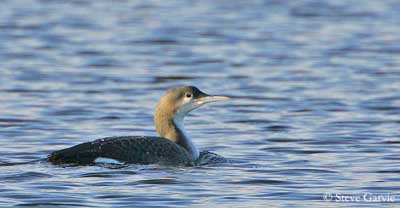
DIET:
The Black-throated Diver feeds almost exclusively on fish of several species. Sometimes, some aquatic insects, crustaceans and molluscs may be consumed, and plant matter too.
